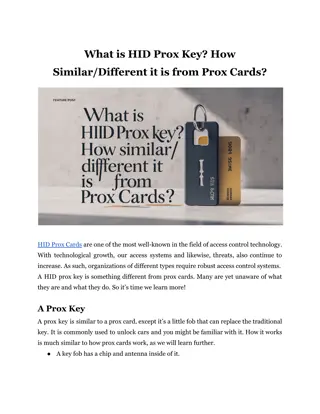
Are HID Prox II Cards Backward Compatible with Older Systems
Wondering if HID Prox II cards work with older systems? Learn about compatibility, usage tips, and how to integrate new cards seamlessly.
Download Presentation

Please find below an Image/Link to download the presentation.
The content on the website is provided AS IS for your information and personal use only. It may not be sold, licensed, or shared on other websites without obtaining consent from the author. If you encounter any issues during the download, it is possible that the publisher has removed the file from their server.
You are allowed to download the files provided on this website for personal or commercial use, subject to the condition that they are used lawfully. All files are the property of their respective owners.
The content on the website is provided AS IS for your information and personal use only. It may not be sold, licensed, or shared on other websites without obtaining consent from the author.
E N D
Presentation Transcript
Are HID Prox II Cards Backward Compatible with Older Systems? In an age where security is paramount, organizations constantly seek solutions that enhance access control while ensuring compatibility with existing systems. HID Prox II cards stand at the forefront of this evolution, offering advanced features designed to meet modern security challenges. But as businesses upgrade their systems, a critical question arises: are these new cards backward compatible with older access control setups that rely on previous generations of HID access control cards? Understanding this compatibility is essential for organizations looking to transition smoothly without incurring unnecessary costs or operational disruptions. This article dives into the intricacies of HID Prox card II, examining their backward compatibility with older systems and the key factors organizations must consider when making this important upgrade.
What are Proximity Cards? Proximity cards are a type of smart card that uses radio frequency identification (RFID) technology for access control. These cards typically operate within a specific range, allowing users to gain entry by simply holding the card near a reader. The convenience and speed of a proximity card make it ideal for a variety of applications, from corporate offices to secure facilities. The shift from older systems to more advanced solutions often raises questions about compatibility. Compatibility ensures that new technologies can integrate seamlessly with existing infrastructure, minimizing disruptions and maximizing investment value. Key Features of HID Prox II Cards: Enhanced Security: They include features that bolster security, such as encryption and increased data capacity. Improved Read Range: These cards often have a longer read range compared to their predecessors, allowing for smoother access experiences. Compatibility with Existing Systems: One of the critical questions is their compatibility with older systems. Are HID Prox II Cards Backward Compatible with Older Systems? Backward compatibility refers to the ability of a new product to function with older systems. For businesses considering an upgrade, understanding this aspect is crucial. The short answer is yes in most cases, HID Prox II cards are backward compatible with older systems that utilize HID access control cards. However, several factors influence this compatibility: Reader Compatibility: The card reader must be able to read the signals from the card. Most readers are capable of reading the newer cards due to the similarities in technology.
System Configuration: Some older systems may require firmware updates or modifications to recognize the HID Prox II cards. It's essential to check with the system provider to ensure compatibility. Card Format: Ensure that the HID Prox II card is formatted in a way that is recognized by the existing system. The card format must match the configuration settings of the older system for proper functionality. Detailed Compatibility Considerations Let s analyze the compatibility factors in greater detail: Card Readers and Their Capabilities Reader Technology: Most older HID access control cards utilize a specific frequency (typically 125 kHz) for communication. HID Prox II cards also operate on this frequency, allowing them to be read by many existing card readers. However, not all readers may support the additional features of these cards, such as their improved security protocols.\ Multi-Technology Readers: Some readers are designed to handle multiple card types and formats. If your organization uses such readers, it s likely that they can handle these cards without issue. Always verify that the reader specifications include support for the newer card formats. Access Control Systems and Firmware System Updates: Older access control systems may require updates to their firmware to ensure compatibility with new card types. This is especially true for systems that rely heavily on proprietary software. Contact your system provider to check if updates are available and necessary.
Database Management: Opting for an HID Prox card II may involve modifications in how access credentials are stored and managed within your access control software. Ensure that the system can support new card formats without losing existing user data. Physical Characteristics and Card Formatting Card Format: They may come in different physical formats (such as key fobs, standard cards, or stickers) that can impact their compatibility with existing readers. It s essential to ensure that the card type you choose is suitable for your existing infrastructure. Programming: They are programmable, allowing organizations to customize the data written on the card. It s important to ensure that the existing system can accommodate these customizable features without issues. Interoperability Testing Conducting Tests: Consider conducting interoperability tests. This involves running a small pilot program where the new cards are introduced into the existing system to assess functionality. This testing can help identify potential issues before a complete rollout. Feedback Loop: Collect feedback from users during the pilot phase to gauge ease of use and identify any unforeseen compatibility issues. Advantages of Upgrading to HID Prox II Cards Investing in HID Prox card II offers several advantages beyond backward compatibility.
Increased Security Measures: As security threats evolve, upgrading to the latest technology provides better protection against unauthorized access. Future-Proofing Your System: Newer cards are designed with evolving security needs in mind, ensuring that your system remains effective against future threats. Operational Efficiency: With features like faster read times and improved reliability, businesses can enhance their operational efficiency when using these proximity cards. Higher Data Capacity: They have a greater data storage capacity, enabling organizations to incorporate more information and support additional functionalities, such as user profiles and access levels. Support for Advanced Features: These cards support advanced features like multi-technology capabilities and mobile credentialing, allowing for more flexible access control solutions tailored to the needs of modern businesses. Enhanced User Experience: With improved read ranges and response times, HID Prox II cards streamline the access process for users, reducing wait times and improving overall satisfaction. Considerations for Organizations Organizations should consider the following: Assessment of Existing Infrastructure: Evaluate current card readers and access control systems to determine any necessary updates or replacements. Training Staff: Ensure that staff are trained on how to use the new cards and understand any changes in the access control process. Phased Rollout: Consider implementing a phased rollout strategy to minimize disruptions. This approach allows organizations to gradually transition to the new cards while ensuring ongoing access for employees.
Technical Insights into HID Prox II Cards To understand how HID Prox II cards work, it s essential to examine the underlying technology. RFID Technology: They operate using low-frequency RFID technology, typically around 125 kHz. This technology allows the cards to communicate wirelessly with card readers. Data Encryption: The newer cards incorporate advanced encryption methods, enhancing security and reducing the risk of cloning. Durability and Longevity: They are designed for durability, making them suitable for high-traffic environments. They are resistant to wear and tear, ensuring a longer lifespan compared to older card models. Troubleshooting Compatibility Issues While they are generally compatible with older systems, issues may still arise. Here are some common troubleshooting steps: Check Reader Specifications: Ensure that the existing readers are compatible with the frequency and technology of these cards. Update Firmware: If issues occur, check if there are firmware updates available for the existing access control system. Contact Support: When in doubt, reach out to customer support, or a qualified technician can provide solutions tailored to specific compatibility concerns. In A Nutshell Transitioning to HID Prox II cards is more than just an upgrade; it's a strategic move towards a more secure, efficient, and future-ready access control system. With the assurance of backward compatibility and a host of advantages including enhanced security, increased data capacity, and an improved user experience organizations can confidently embrace this innovative technology.
At Bristol ID Technologies, we specialize in providing cutting-edge access control solutions, including the latest HID Prox card II. Our expertise ensures that you receive not only the best products but also the support necessary for seamless integration with your existing systems. Upgrade your security with confidence contact us today to learn more about how our solutions can meet your unique needs! Site Article: Are HID Prox II Cards Backward Compatible with Older Systems






















